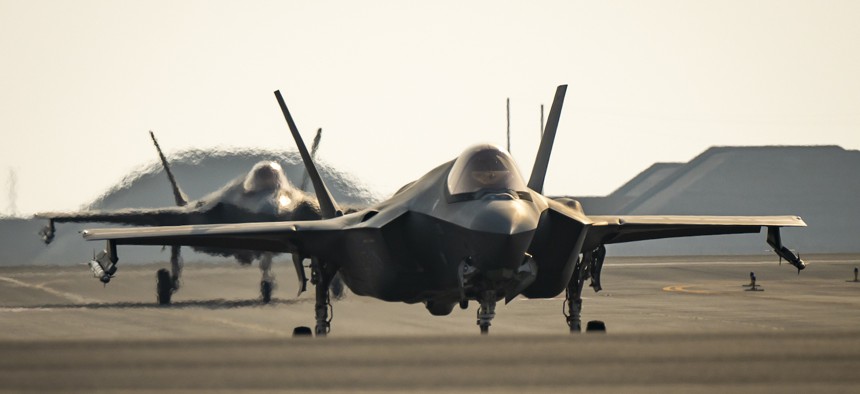
Two U.S. Air Force F-35A Lightning II aircraft from the 421st Expeditionary Fighter Squadron taxi off the runway at Al Udeid Air Base, Qatar, Sept. 5, 2023. U.S. Air Force / Tech. Sgt. Leah Ferrante
As Lockheed hungers for F-35 sustainment deal, Pentagon says it might not happen
Company officials no longer expect DOD to approve a switch to performance-based logistics by year’s end.
Lockheed Martin says a new five-year deal to sustain the F-35 fleet won’t be reached by the end of this year. The Pentagon says it might not happen at all.
“For the F-35 program, and its continually expanding fleet, the process to put such a contract in place is complex, and we will take the time necessary to get it right. If we are unable to do so, we will move forward with another way to meet warfighter sustainment requirements. In the meantime, we continue to provide support through our existing contracts,” F-35 Joint Program Office spokesperson Russ Goemaere told Defense One in a statement.
Lockheed had long provided spare parts and sustainment services for the Pentagon’s F-35 under a succession of annual cost-plus-incentive contracts. In September 2021, DOD and Lockheed finalized a sustainment contract for fiscal 2021 to 2023 that included a mix of cost-plus-fixed-fee, and cost-plus and fixed-price incentive fees. But since 2019, company officials have been working to persuade DOD that it should move to five-year performance-based logistics, or PBL, contracts, under which the company would be paid to produce outcomes, not provide quantities of parts and services.
Company officials have previously said they expected the new PBL contract to be finalized by the end of the year. However, that timeline has now been pushed to next year, Jay Malave, the company’s chief financial officer, said Thursday during a Morgan Stanley conference.
“We've already submitted a proposal to the Joint Program Office for sustainment. Originally, we were expecting that we can get into contract by the end of the year. It probably will extend out to the beginning of next year,” Malave said.
But such a deal must itself meet performance requirements imposed by Congress in the 2022 National Defense Authorization Act, which requires the Pentagon to show that this contract would either lower sustainment costs or increase readiness.
“The program is working with Lockheed Martin to put in place a sustainment contract that continually improves our performance in meeting warfighter readiness requirements, and that meets congressionally directed certification requirements,” JPO’s Goemaere said.
The Pentagon does have some qualms over committing to the PBL deal, according to Ray Jaworowski, an analyst with Forecast International, a corporate sister to Defense One.
While a firm fixed-price deal would transfer financial risk to Lockheed, “some concerns exist that a significant amount of flexibility could be lost if the Pentagon is locked into a multiyear deal, particularly if the cost savings and readiness improvements do not materialize as expected,” Jaworowski said.
At the Morgan Stanley conference, Lockheed CEO Jim Taiclet also talked about the recently announced delays to the newest F-35 technology configuration, dubbed TR-3.
“This is a major hardware upgrade. With that will come a major software upgrade but the fact that much of the hardware was late and some subcomponents to that hardware was also late in front of it—that compresses the software integration test program dramatically. And both government and industry wanted to try to keep the original schedule as much as we could and we're just not able to do that,” Taiclet said.
In a recent public filing, the company announced that the planes in the TR-3 configuration won’t be delivered until at least April and possibly June. Taiclet echoed an earlier company statement in citing delays to the Integrated Core Processor, essentially the brain of the airplane, built by L3Harris.
Air Force officials said they won’t be surprised if Lockheed can’t start TR-3 deliveries by the updated timeframe.
“I would call that timeframe not low risk. It’s high risk,” Gen. Mark Kelly, head of Air Combat Command, told reporters Tuesday at the Air & Space Forces Association’s annual Air, Space & Cyber conference.
Kelly said he’s confident that the TR-3 software and hardware is what’s needed to combat future threats, but “there’s still a ways to go.” The new schedule is “doable,” he said, but it will be “hard work.”
Lockheed will be required to deliver about a dozen TR-3 jets per month in 2024, according to the JPO. However, the Pentagon is refusing to accept the jets until they can pass certain tests, meaning Lockheed might have to sit on up to 124 jets if the delay lasts until June.
“Projected TR-3 deliveries for 2023 are 52 and beginning in 2024, projected TR-3 deliveries are anticipated at approximately 12 per month,” Goemaere said.
Asked about the potential 124 jets that could be sitting in storage, Andrew Hunter, the Air Force’s acquisition chief, said the program had an “aggressive” approach to get TR-3 fielded.
“I think leaning forward in the situation that we're in is the right thing to do. Did we lean forward too much? Well, we are where we are,” Hunter told reporters Monday at the AFA conference.
Another problem is there are “real limits in our infrastructure” to test and deliver the new tech, Hunter said.
“A real lesson learned coming out of this is that we've got to open the aperture and allow us to field these faster and they're concrete things we can and will do to accomplish that,” he said.
NEXT STORY: Conference Wire: Air, Space & Cyber 2023, Day 3


